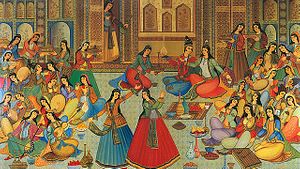“While not much of a commercial route, the Silk Road became the planet’s most famous cultural artery for the exchange between East and West of religions, art, languages and new technologies,” Yale Professor and Silk Road scholar Valerie Hansen wrote in 2013. Calling the famed Silk Road “more a network of pathways than a road” Hansen underscored that while we may think of trade as the road’s purpose, it’s lasting impact and overwhelming influence was cultural transmission.
With that history in mind, modern attempts by regional governments to separate traditional cultural elements out from foreign imports–to pick out that which is not native and cast it aside–rings hollow.
Bruce Pannier this week noted a story picked up by RFE/RL’s Uzbek bureau:
RFE/RL’s Uzbek Service, known locally as Ozodlik, has learned there is a ban on the use of a stringed instrument called a “tar,” which literally translates as “string.” Officials believe the tar is not part of the orchestration of traditional Uzbek music.
The instrument in question–a slender-necked, double-bowled, stringed instrument–has roots to the west of Central Asia: Azerbaijan and Iran. The instrument–or its predecessor–appears in paintings from the Safavid dynasty. At its height the Safavid’s empire stretched from the Caucasus across the Persian heartland and into Central Asia. Notably, in 1505 Uzbeks occupied the famed city of Merv (now Mary in modern Turkmenistan) and in 1510 were expelled by the Safavids. The city remained mostly in Safavid hands–except for brief periods of Uzbek rule–until it was taken by the Emir of Bukhara in 1785 and razed in 1789. It’s unclear when the tar first came into Uzbek hands, but it was quite literally hundreds of years ago.
As Hansen said, the Silk Road was a “cultural artery.” But in addition to trade, war and conquest have also infused the region with a distinct cultural dynamism as conquerors from the region traveled outward–like Timur all the way to Ankara and Babur to India–and others passed through–like Alexander, Genghis Khan, and ultimately Imperial Russia. At each step, local peoples kept and assimilated what they found useful or beautiful.
As Pannier notes, at independence the five new states of the region strove to define themselves vis-a-vis their new neighbors. Delineating what exactly is “Uzbek culture” and what is not has been a part of that effort.
Uzbekistan is not alone in fighting foreign influences, ancient or more recent. A first target for Tajikistan had been Russian and Soviet influences: Russian names in particular got increased attention when Emomali Rahmon dropped the -ov suffix from his name. Last year a law was proposed to ban Islamic-sounding names. No word on if Rahmon would then change his first name (a form of Imam Ali, a distinctly Islamic name). Also in 2015, the mayor of Dushanbe ordered that shops quit selling black clothes, saying “our people never wore black clothes.”
Of late, many of the regional efforts to purify local culture–like the series of billboards in Kyrgyzstan featuring women in hijabs and the headline “My poor people, where are we headed?!”–focus on the influence of Middle Eastern cultural notes, in particular clothing. But as the Uzbek rejection of the tar shows, the urge to distill local culture hits on influences from near and far, both in time and space. The governments are not always very clear in their reasoning–why remove the tar now (and the accordion too) and not before? How far back does one have to go to before arriving at traditional Uzbek culture, unadulterated by foreign influences?
































